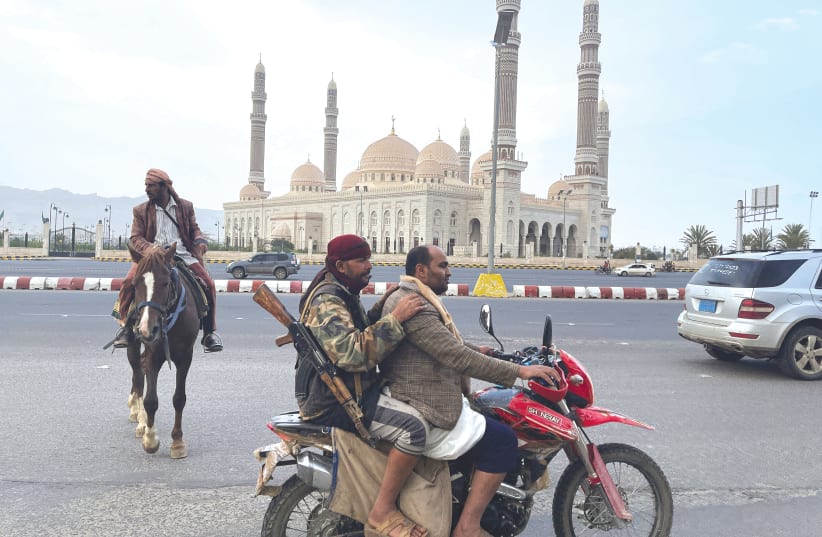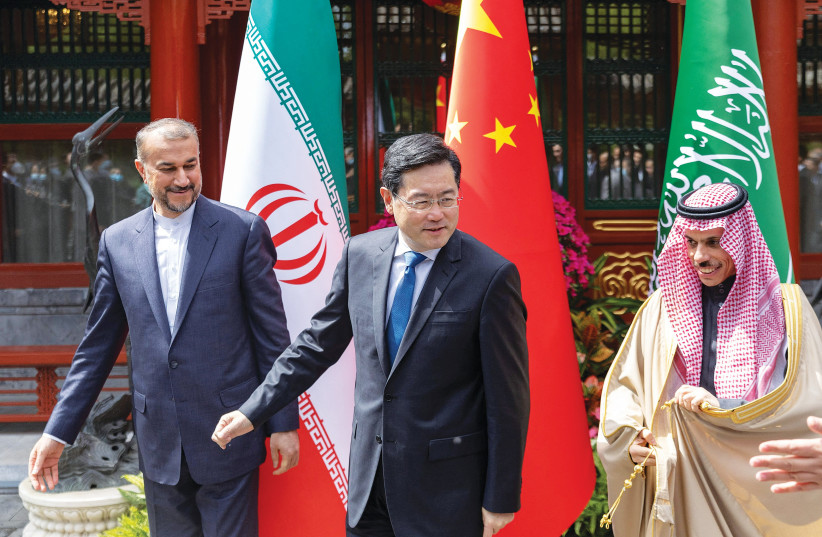The issue of Yemen constituted a key litmus test in the recently concluded rapprochement between Iran and Saudi Arabia. Since the launch of the Houthis’ bid for power in 2014 and the Saudi intervention to prevent the strategic disaster of a pro-Iran force reaching the choke point of the Bab el-Mandeb Strait, Yemen has formed the main battlefront between Riyadh and Tehran.
More than 150,000 people have been killed in the subsequent war, including 14,500 civilians. In light of this, the question of future arrangements in that blighted country looms large when considering the feasibility of the current Arab efforts to defang, via diplomacy, the Iranian project for regional domination.
Yemen may seem far from Israel, but events there are also of direct relevance to Jerusalem. The Ansar Allah movement, or Houthis, is a major instrument of the Iranian regime. Alongside Lebanese Hezbollah, they appear to be Tehran’s preferred instrument for strategic operations that the Iranian regime prefers not to undertake with its own forces.
The Houthis, for example, were allegedly responsible for the single most effective strategic act of war undertaken by the Iranian regime over the last half decade: the drone attack on the Saudi Aramco oil processing facilities at Abqaiq and Khurais on September 14, 2019. As a result of the attack, Saudi oil production was immediately cut by half, and production was substantially reduced in subsequent weeks.
The attack, and the feeble Western response to it, were major contributory factors in setting Saudi Arabia on its current trajectory of Chinese-mediated rapprochement with Iran.
No international observers believe that the Houthis had or have the independent capacity to launch an attack of this magnitude or impact. The Abqaiq and Khurais operations, therefore, demonstrated the Iranian ability to conduct major acts of aggression, which would be seen as acts of war were they to be carried out by official state forces, while avoiding consequences or responsibility for them.
This Iranian capacity, vis-a-vis Yemen but also in Iraq, Syria, Lebanon, the Gaza Strip and West Bank, constitutes Iran’s disruptive capacity in the regional context. The goal of current Arab diplomacy is to induce the Iranians to agree to abandon this mode of activity in order to enable the return, for the first time in more than a decade, to something resembling stability in key parts of the Middle East.
AS PART OF the agreement, Iran reportedly agreed to cease covert weapons shipments to the Houthis in Yemen, enabling the resumption of diplomatic relations between Iran and Saudi Arabia. A March 16 report in The Wall Street Journal quoted US and Saudi officials as confirming the Iranian commitment to this.
Iran, incidentally, has consistently denied that it ever supplied the Houthis. For a period, such claims were taken seriously in Western chancelleries. Israel and others, which challenged the Iranian claims, were accused of simplifying the picture, failing to understand the authentic local nature of the Houthis and the inapplicability of a “one size fits all” model for the Iranian management of regional proxies.
Such pieties have been quietly abandoned in recent years in the face of growing evidence of active Iranian support. In recent years, UN inspectors have consistently traced arms shipments to the Ansar Allah movement back to Iran. Some of the weaponry intercepted went far beyond the light capacities that would usually be associated with an insurgency in a developing country.
For example, in November 2022, US naval forces deployed in the Gulf of Oman intercepted a fishing boat on its way from Iran to Yemen. The boat was found to be carrying more than 70 tons of aluminum perchlorate, a chemical used to fuel mid-range ballistic missiles.
The Iranian commitment to cease these supplies is, therefore, a key test of the feasibility of the rapprochement and of Arab diplomacy regarding Iran more broadly.
AFTER TWO months, the first evidence is now available as to the results. A May 11 report at the al-Monitor website quoted US special envoy to Yemen, Tim Lenderking, as confirming that as of now, at least, the March rapprochement has not stopped the continuing supply by Iran of its Houthi clients.
Al-Monitor quoted Lenderking as saying that Iran has “armed and trained and equipped the Houthis to fight and attack Saudi Arabia… These attacks have not taken place for over a year, but the Iranians have continued to smuggle weaponry and narcotics toward the conflict.”
Reuters quoted Lenderking on May 11 as confirming that “The Iranians have continued to smuggle weaponry and narcotics toward this conflict, and we are very concerned that this would continue despite the benefits that would come from a Saudi-Iran deal. So I think that is a space we have to watch.” The US, Lenderking concluded, remains “concerned about Iran’s role” in Yemen.
The US envoy did not give detailed information regarding the basis for his assertion. Assuming that it is accurate, the implications are significant and not encouraging for Saudi regional strategy. A six-month ceasefire collapsed in October 2022, when the Houthis declined to renew it. Continued Iranian supplies and improvement of the capacities of the Ansar Allah organization indicate that no substantial change has taken place in Tehran’s stance toward its clients.
No alteration in Iran's behavior
LENDERKING’S statements would suggest that Iranian-Saudi “rapprochement” is not actually producing any major alteration in Iranian behavior vis-a-vis Yemen. In this regard, the emergent evidence is matched by indications from farther afield.
A May 9 report by the opposition-associated Syrian Observatory for Human Rights looked into the pattern of activity of Iran-supported militias in Syria, in the context of the current return of Syria to the Arab diplomatic fold. This return of Syria to full membership of the Arab League constitutes a parallel process to Arab outreach to Iran, pioneered by the United Arab Emirates and now also taken up by Saudi Arabia.
The Observatory noted that two Iran-associated militias in Syria – the Afghan Shia Fatemiyun and the Pakistani Shia Zeinabyun – have in recent days lowered the Iranian flag and their militia banners from their positions in southeast Syria. At the direct request of the Assad regime, the militias have raised the Syrian regime flag in their place.
The report mentioned Deir al Zur city, the town of Mayadeen and the area of Albukamal close to the Syrian-Iraqi border as the locations where these changes of identification occurred. The Observatory also said that similar actions had been taken farther west, in the area of Palmyra in the Homs province.
Noting the Syrian regime’s verbal commitments to the Arab states regarding the reduction of Iran-associated militias in return for the normalization of relations, the Observatory wrote that as of now, the changes are “informational only.” That is, the “full presence” of the militias remains, and no element has in fact been withdrawn. Only the banners have changed.
So as of now, the litmus test of Yemen, and the additional emerging evidence from Syria, would suggest that Iran and its allies are receiving the diplomatic benefits of commitments to a change in behavior, while continuing to behave in all essentials exactly as before. This should come as no great surprise, given the centrality of Iran’s regional ambitions to the core ethos of the regime and the importance of the use of franchise militias in advancing these aims.
Arab (and Western) observers would do well to note the provenance of the Persian proverb regarding “Ham Khoda-ro mikhad ham Khorma-ro,” concerning one who wants “both God and the dates.” That is, the concept of having one’s cake and eating it too has a long history in this vicinity.

